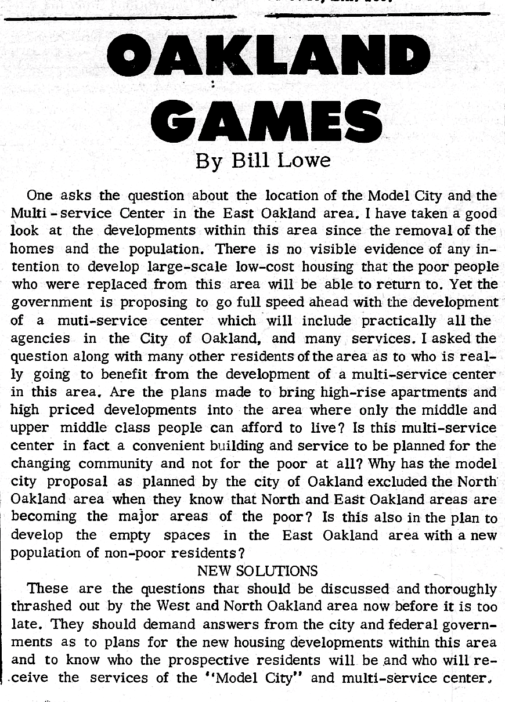In this installment of his “Oakland Games” column, Flatlands contributor William (Bill) Lowe anticipated the battle for community control over the Model Cities program, slated to transform West Oakland with federal funding, and questioned the construction and utility of a proposed multi-service center in East Oakland.
As with a host of other mid-20th century American cities, Oakland’s municipal woes derived in part from aging housing stock and industrial infrastructure, and battles over urban renewal proposals meant to address so-called “blight” had animated and politicized Oakland residents since the 1950s. In particular, the controversial Acorn redevelopment project had acted as an impetus for subsequent community and political organizing in West Oakland and beyond. Enacted by the Oakland Redevelopment Agency (ORA) and supported wholeheartedly by the city’s political class, the Acorn project entailed an expansive commercial and industrial overhaul of a section of West Oakland primarily consisting of low-cost housing.
While ORA and city officials had hoped to “revitalize” a neighborhood they saw as blighted and under-valued, displaced residents and their neighbors saw the project as an existential threat, carried out by a government indifferent to their wishes and needs.
Battles over urban renewal initiatives led to the formation of groups like the Oak Center Neighborhood Association, led by the legendary activist Lillian Q. Love. Oak Center adjoined Acorn, and when its residents learned that the city planned to redevelop their neighborhood in a similar fashion, they sought through demonstrations and meetings with officials that residents opposed the kinds of block-clearing measures that had been imposed on Acorn. In the end, pressure from OCNA and other groups led to substantial modifications to the redevelopment proposal.
This victory helped to spur the formation of similar neighborhood associations across the city, whose members appeared in the pages of The Flatlands and worked in concert with activists and social workers to achieve greater community input in the city’s anti-poverty programs. It was in this context of profound mistrust of city officials and institutions, amid the growth of left-wing grassroots activism in the East Bay, that the battle for the Model Cities program took shape. Bill Lowe’s cautionary questions speak to this atmosphere of mistrust, and to the ongoing mobilization at the grassroots level to modify or scotch these projects.
Throughout much of 1968 and 1969, neighborhood activists and community leaders would learn from previous setbacks and make unprecedented demands from federal anti-poverty officials for autonomy and self-determination.
